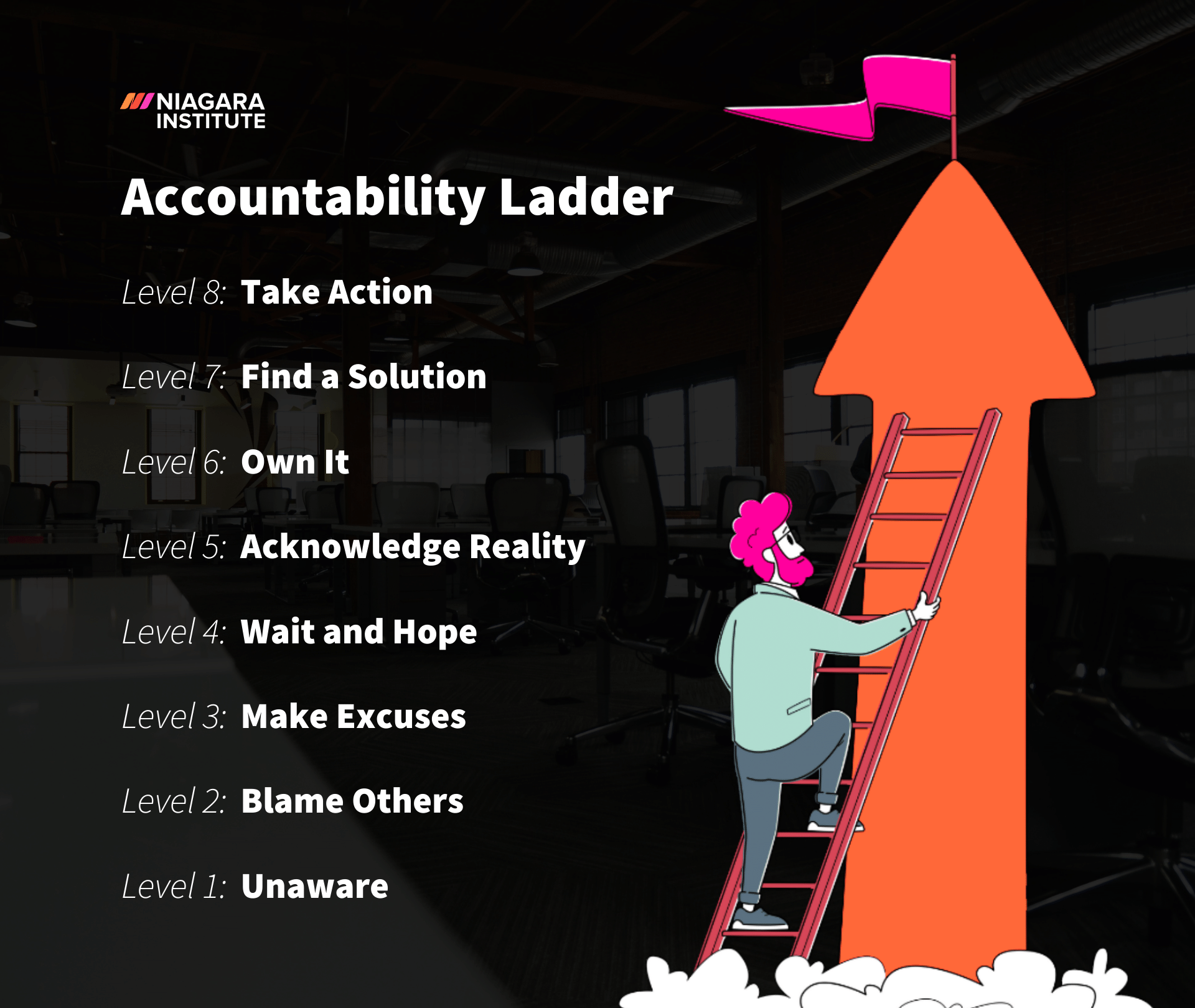5 min read
Assessment: Is Your Team Lacking Accountability?
Leaders in all departments and industries want their teams to be highly accountable - and for a good reason! When your team follows through on...
5 min read
 Michelle Bennett
:
Dec 1, 2022 5:00:00 AM
Michelle Bennett
:
Dec 1, 2022 5:00:00 AM
.png)
Every leader wants employees to take responsibility for their words, actions, and results - whether good or bad - yet 25% report that they feel this level of accountability is absent on their team.
If you feel the same and could use extra support holding your employees accountable, then you need to know about the accountability ladder. In this article, we’ll review what it is exactly and how you can use it in your day-to-day life as a leader.
The accountability ladder is a tool that helps leaders and employees identify one’s level of accountability, from 1 (the least accountable) to 8 (the most accountable). It was widely made popular back in 2007 by Bruce Gordon, the then-president of the NAACP, an American civil rights organization.
He explained that people on levels 1-4 of the accountability ladder typically believe things happen to them and behave as the victim, whereas those on levels 5-8 believe things happen because of them, and they behave in ways that are proactive and truly accountable. The exact levels on the accountability ladder are as follows:

Let's dive into the seven rungs of the ladder, moving from the bottom to the top:
This person isn’t even aware of the situation or that a problem may exist. They say things like, “I didn’t know” or “No one ever told me.”
This person might be aware of the situation or problem, but they aren’t willing to take responsibility for their part in it. Instead, they choose to blame others by saying something like, “You weren’t clear.”
Again, this person is aware but unwilling to take full responsibility for their part in a situation or problem and make excuses as to why. They will say something like, “I can’t because…” or “Well, that’s the way we’ve always done it.”
This person is aware of a situation/problem but decides to take the passive wait-and-see approach. They either hope it will go away, resolve itself, or go unnoticed by their teammates or leaders.
This person knows of the situation/problem and acknowledges that something needs to be done about it. They might say something along the lines of, “I should have done it.”
This person doesn’t just know about the situation/problem; they’re willing to own their part in it and explore what to do about it. Owning it may sound something like, “I won’t make that mistake again.”
This person acknowledges the situation/problem, takes responsibility for their part, and actively commits to finding a solution. For example, they would say something like, “Here’s what I’m going to do about it…”
This person is truly accountable. They acknowledge the problem/situation, own their part, find a solution, and then say, “I’m on it,” and put that solution into action.
The magic happens when you move above the red line, transitioning from blame and excuses to acknowledgment and action. This change in mindset is key to personal growth and success.
Think of these levels as a tool for self-reflection. When facing a challenge, ask yourself: "Where am I on this ladder?" The higher you climb, the more in control you'll be of your life and your goals.
Let's break it down:
So, the next time you're faced with a challenge, think about where you are on the accountability ladder. Climbing higher will not only help you solve the current issue but also boost your personal and professional growth.
Accountability ladder focuses on individual behaviors leading to accountability.
Picture a ladder with rungs—each step up means you're becoming more responsible and proactive. The bottom rungs are all about playing the blame game and making excuses. As you climb higher, you start taking ownership of your actions and finding solutions to problems. It's a straightforward way to see where you stand in handling challenges.
The accountability pyramid emphasizes hierarchical structures and organizational processes supporting accountability. The pyramid structure highlights levels of responsibility from the base (team members) to the apex (leaders), each supporting the other to uphold accountability across the organization.
Imagine a pyramid with different sections. At the base, you have the foundational skills needed for accountability, such as honesty and reliability. As you move up, each level adds more complex skills like leadership and decision-making. The top of the pyramid is where you're a full-fledged accountable leader, taking responsibility not just for yourself but also guiding others.
This one is all about understanding your duties and roles—both personally and professionally, it's about knowing what you should do and actually doing it.
The responsibility ladder is like a checklist of what you're supposed to do in your job or personal life. The higher you climb, the more responsible you become, taking on bigger tasks and handling them well.
Whether you're thinking about ladders or pyramids, the key is to keep improving. Both the Accountability Ladder and Pyramid help you focus on becoming more responsible, reliable, and effective. They're just different ways to visualize your growth.
Accountability can be one of those skills that feel elusive and hard to grasp for some. In which case, the accountability ladder can help solve that. Not only does it give something for you to reference during conversations about accountability, but it also gives your employees something tangible to visualize what it means to be truly accountable.
In fact, we recommend saving or printing out a copy to have on hand for easy reference in situations where you need to hold employees accountable.
For example, begin using the accountability ladder during your weekly one-on-one meetings. When you’re discussing progress, deadlines, and feedback, watch if your employees are demonstrating victim or accountable behaviors. Where would you put them on the accountability ladder? If you find that they aren’t where you want them to be, then bring their attention to the accountability ladder, point out where they are currently and why, and then identify where you want them to be, so they know what they need to be working towards.
Start meetings by addressing where projects stand in terms of accountability. Use the ladder as a backdrop to discuss progress and setbacks.
Incorporate the Accountability Ladder into performance assessment criteria. Evaluate employees not just on results but also on their journey towards taking ownership and being proactive.
When conflicts arise, use the Accountability Ladder to diagnose behaviors contributing to the problem. Guide involved parties to move up the ladder by addressing their roles and responsibilities.
Develop training modules that include the Accountability Ladder, helping existing and emerging leaders understand its importance and application.
Getting your employees to take responsibility for their actions and truly become accountable isn’t always easy, but having practical tools, like the accountability ladder, can help. What can also help is investing in a leadership training program or one-on-one coaching package that hones your leadership skills and provides you with additional insights, tricks, and tools related to holding employees accountable.
.png)
5 min read
Leaders in all departments and industries want their teams to be highly accountable - and for a good reason! When your team follows through on...

5 min read
Many times throughout my career, I have committed to taking accountability for results, where on reflection, I wish I had asked more questions and...

4 min read
What does responsibility mean? What does accountability mean? Does your organization treat them as interchangeable terms leaving you wondering what...